Origin of Some Rajput Clans – I
By Smita Mukerji
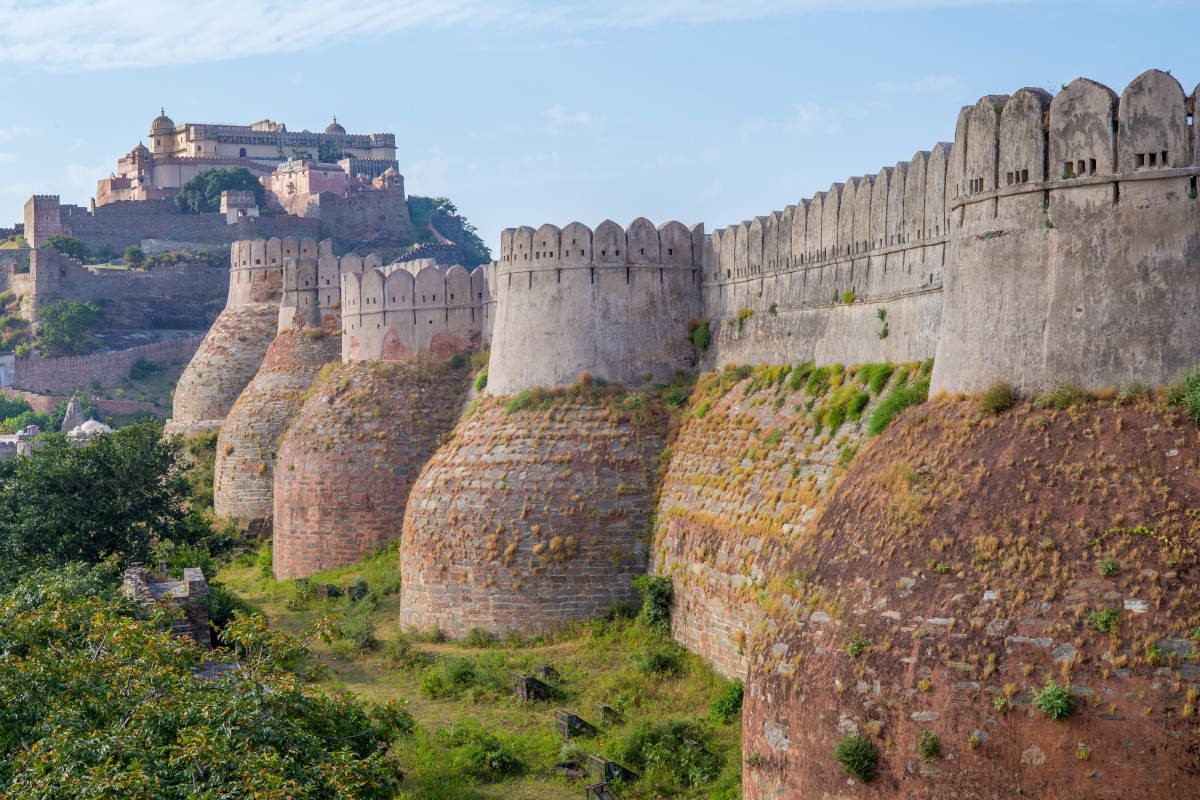
Another Twitter altercation later and a few shades wiser… that it is not possible to gain any understanding, establish any truth in the raucous, fraught social media world.
A handle purporting to represent ‘Rajput pride’ recently pounced upon a tweet by another person that spoke of possible Brahmin origin of the Sisōdiā Rajputs. I am unaware of the background or motivation of the handle that made the initial claim (both these handles are anonymous), but the barrage of negative commentation and rancour that followed is nonplussing.
And like the usual me, that finds it irresistible to undeceive people on their pretensions (especially the ones who throw these around obnoxiously as ‘expert opinions’) I put my oar in! (I scold myself ever so often to desist, but there it is…😐) This leaves me to sort out and put together my view on another controversy, which though has been discussed exhaustively by historians within reams, they obviously could not have anticipated that politically charged social media clamour would unceremoniously unseat considered scholarly opinion and boorishness and braggadocio will take its place.
Since this controversy is longstanding and wide-ranging with a plethora of claims and myths, I opted for a write-up rather than instant Twitter repartees.
The crux of this debate regarding the origins of the various clans of Rajputs is, what is claimed by the respective clans themselves, since the actual origins are mostly obscure and lie in the remote past. But it is important to recognise that these claims have also changed over time. The view of ‘purity of blood’ became hardened only in the recent past, as late as the 20th century, as caste delineations became rigidified owing to British enumeration and employment policies, in particular, community and caste identity as the basis for eligibility for government and military service—the latter being one in which the Rajputs had a significant stake.
It is amusing to see some of those professing to be Rajputs sustain affront at the suggestion that the Guhilas or Guhilōts had Brahmin origins, as this appears to have been generally known and proudly flaunted until the not so distant past. The general impression today of the Guhilas being ‘Suryavanshi Rajputs’ was hardly the established idea all along.
The three chief contentions regarding the origins of the Guhilas—and some other prominent Rajput clans, which are all interconnected—that constitute this debate, are: a) Brahmin origin, b) Kshatriya lineage, and c) foreign origin. There is also a marginal view of them having had tribal beginnings who rose to prominence subsequently. But the last of the three main views, contrary to what the ‘Rajput club’ imagines, has been prevalent since the 16th century. It was not propounded by the illustrious historian, ethnologist and political scientist, Devadatta Ramakrishna Bhandarkar. It was not cooked up by British writers nor adopted uncritically from them. Incidentally, the view that the Marāṭhā king Śivājī belonged to Sisōdiā lineage also arises from legends of similar vintage or thereabouts, which in turn is linked closely to the question of the origin of the Sisōdiās itself. But the merits of that claim is a discussion for another day.
Bhandarkar merely collated the entire available evidence, literary, epigraphic and traditional, a phenomenal body of work referred to by historians till date (which is why I asked this person behind the Twitter handle to tell me which book of Bhandarkar was he referring to in his diatribe against the venerable scholar, because these are primarily lists and commentaries, not discursive and certainly not polemical), and accepted two of the possibilities (#s 2 and 3) which, to him, appeared most plausible. It suffices to say, except #3, every one of these views (brāhmaña, kśatriya or tribal origin) remain a possibility, as the origin claimed in Rajput sources may not be the actual origin at all.
Bhandarkar’s paper was at any rate on foreign elements within the Indian population, not specifically on Rajputs. Even if the foreign origin view about some of these Rajputs (based on an erroneous interpretation of what constituted the term ‘Gurjara’ and ‘Gurjaradēśa’, and a highly speculative interpretation of the agnikula legend[1]) has since been disproved and discarded, the speculation was not entirely unfounded as there were definitely more than one not insignificant sources since the medieval era itself which speak of these.[2] It is moreover sufficiently borne out from evidence that, even if not originated outside, there was admixture of foreign blood in Rajputs, as indeed in many ‘castes’ of India, and he was equally unsparing towards the Brahmin caste on account of the caste-purity delusion nursed by them. His eminently sensible and sincerely constructive view was:
“There is hardly a class or caste in India which has not a foreign strain in it. There is an admixture of alien blood not only among the warrior classes—the Rajputs and the Marathas—but also among the Brahmins who are under the happy delusion that they are free from all foreign element. If the Brahmanas have not escaped this taint, as we have seen, and yet call themselves Brahmanas, it excites the risibility of the antiquarian or the ethnologist when he finds some Brahmana castes strenuously calling in question the claims of certain warrior classes to style themselves Kshatriyas. The grounds of this strenuous opposition stated by the Brahmana castes, are that pure unmixed Vedic Aryan blood does not run through the veins of those warrior classes. Yes, this is quite true; but it is equally true that pure Vedic Aryan blood does not run through the veins of the Brahmanas also. Looked at from the antiquarian or ethnological point of view, the claims of either community to such purity are untenable and absurd. As the chief thing valued by the members of the higher castes, viz., purity of blood, the absence of any admixture of aboriginal or foreign blood, has been proved to be hollow and non-consistent, the caste jealousies and controversies, which cause immense mischief, are really useless and meaningless. It is to be sincerely hoped that the knowledge furnished by ethnology and the body of ancient inscriptions will spread among the people, and open their eyes to the emptiness and ruthlessness of the thing they are fighting for, and put an end to all caste animosities and disputes, which are the bane of India.”[3]
To put it succinctly, ‘caste’—which is a misnomer for varñāśrama dharma—was merely the calling by birth, with sufficient pliancy in the system to alter it according to the aspirations of the various groups, including admitting foreign groups, which is what Bhandarkar sought to show with the vast body of epigraphical evidences marshalled by him. His view was purely that of an academic. He really had no axe to grind in this. But unfortunately, this is not the same with caste demagoguery which is beginning to rear its head in a disturbing manner through social media discourse, especially through a whole lot of dubious handles.
Most of all, the prejudiced slurs directed at groups on the basis of regional identity of these scholars, is dismaying. It is such demagogues who have propagandist motives of the most harmful kind. Another contemporary writer, who was the spearhead of the ‘Kshatriya origin’ view, Chintaman Vinayak Vaidya, was also a Maharashtrian. R. R. Halder was in support of this view. D. C. Ganguly was one of the first writers to firmly refute the foreign origin theory as well as the idea that the term Gurjara implied a tribe at all. So the bile against Marathis and Bengalis, two communities which pioneered Indian cultural nationalism, and committed academicians from them whose contributions in documenting the civilisational history of India is peerless, is as baseless as it is reprehensible. It is unfortunate that the real Rajputs, unlike the ones likely hiding behind such anonymous handles, are getting sucked into this vortex of regional animosity.
But getting back to history, I briefly analyse here some of these stories and evidences regarding specifically the Brahmin origins of some prominent Rajput clans. It may be mentioned at this point that the use of the general term ‘Rajput’, given by Muslim chroniclers to these dynasties, is itself erroneous as no such homogeneous class of ruling people existed.
Pratihāras
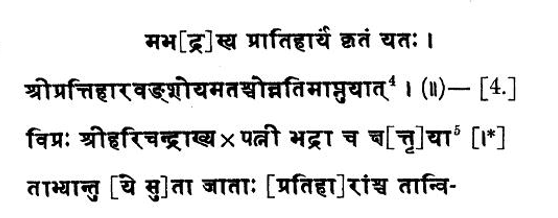
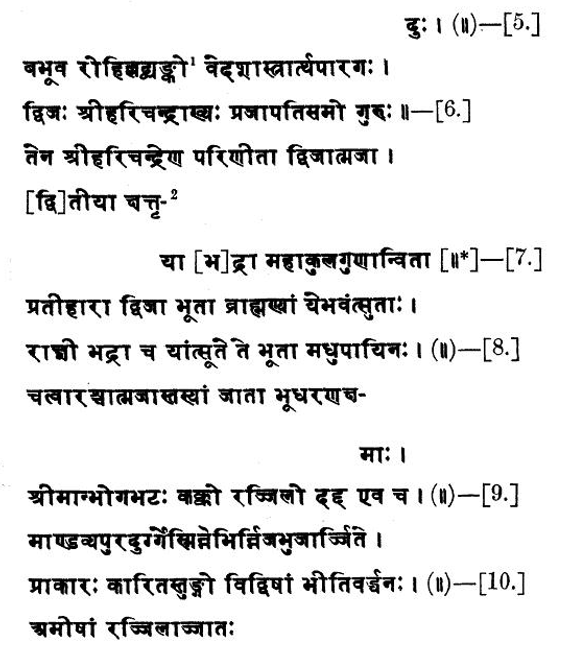
The upsurge of the imperial dynasties of Pratihāras, Paramāras and Ćaulukyas began with the rise of Harićaṇdra (referred to as ‘Gurjaranṛpati’, or overlord of the Gurjaras), the progenitor of the Mandōr Pratihāras, in ca. 550 CE. According to the Jōdhpur inscription of his descendant Kakkuka, 837 CE (Epigraphia Indica, vol. XVIII: 87ff) and the Ghaṭiyālā inscription, 861 CE (Epigraphia Indica, vol. IX: 277ff) of Bāuka (r. 825–861 CE), Harićaṇdra, otherwise called Rōhiladdhi, was a learned brāhmaña well-versed in the Vēdas. His sons (Bhōgabhaṭa, Kakka, Rajjila and Dadda) from his Kshatriya wife Bhadrā, are said to have established the kingdom of Maṇḋavyapura (Maddodāra or Maṇḋōwar, the ancient capital of Marwāḍ) and Mēdaṇtaka (Mēḍata).
The Ghaṭiyālā inscription also tells us that Harīćaṇdra was the preceptor of the Pratihāra family.
The former, dated 837 CE, says that his dynasty was named after Lakśmaña who served as door-keeper (pratihāra) to his brother Rama.[4] The Jōdhpur inscription mentions that the Pratihāra Brahmins descended from another wife, a Brahmin. (V. 8)
The relation between the Pratihāras of Maṇḋavyapura and those of Ujjaina (who later became the rulers of Kannauj) is not clearly established, but the commonality of names occurring in both lines (Kakkuka, Nāgabhaṭa, Bhōja) suggest a close relation. They likely had a common origin.




The Brahmin origin of the Pratihāras may be considered to constitute the most conclusive proof that the Gurjaras were not foreigners, since it was though not unusual for foreign groups to be admitted within the social order of India, the yavanas or mlēććhas, as they were called, were mostly designated śudras or, in case they were warriors or military leaders, kśatriyas, but it was unheard of (and impossible owing to the principles of varñāśrama dharma) for any class of foreigners—or even Indians[5]—to have been made Brahmins.[6]
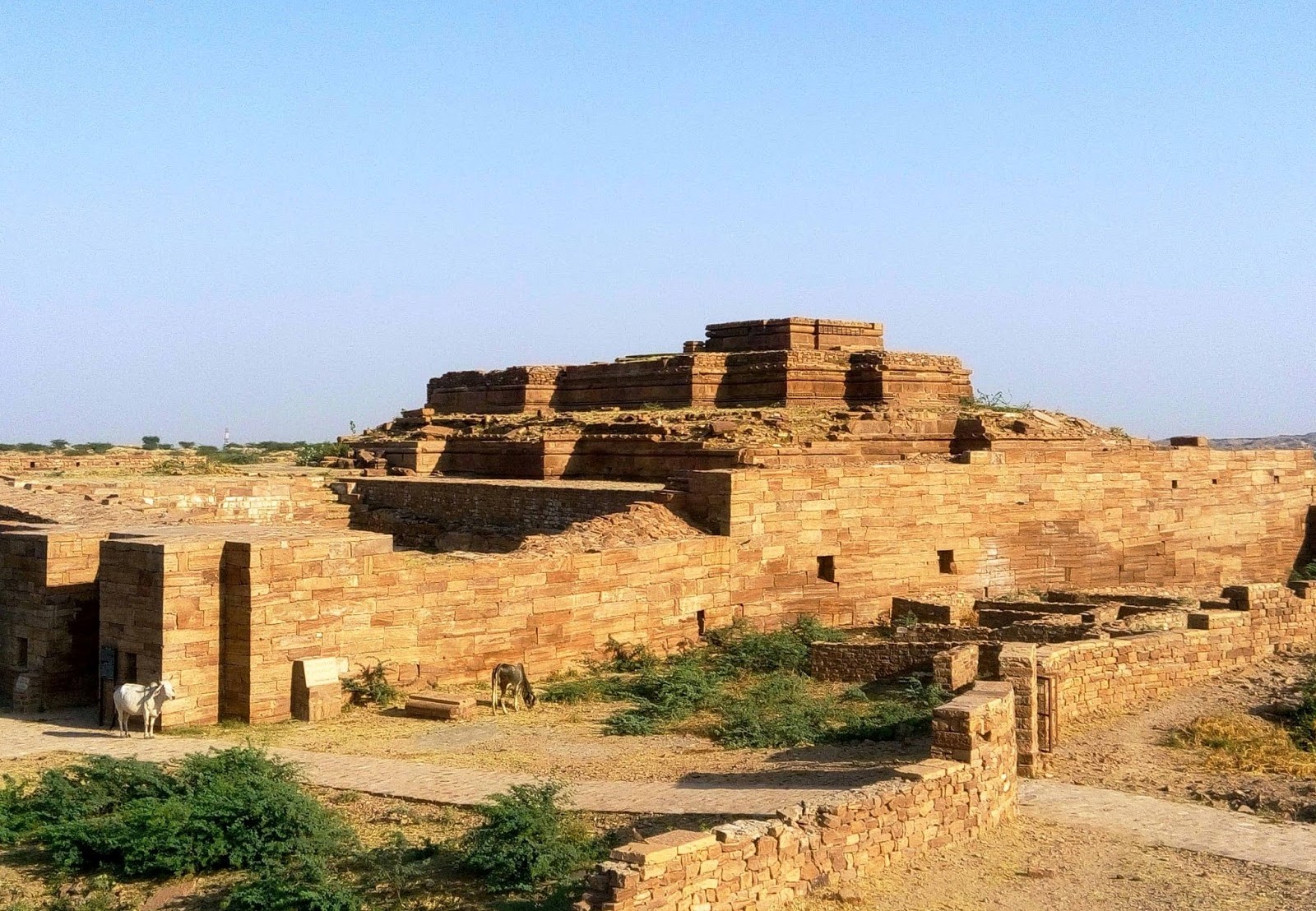
Paramāras

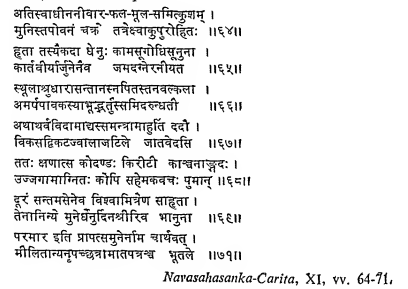
The legend of the agnikula sacrifice performed by the sage Vaśiṣṭha on Mount Ābū is a recurring theme in Paramāra inscriptions narrating the story of the origin of this clan of Rajputs.
The Navasāhasāṇka Ćarita (Figs. 7–8), composed 996-1000 CE, by Padmagupta aka ‘Parimala Kalidāsa’, court-poet of Vākpatirāja Muṇja and his younger brother, Sindhurāja Navasāhasāṇka, is the most reliable source of Paramāra history. This eulogy to Sindhurāja, the father of Bhōjadēva, traces the origin of the Paramāras to the ‘wise priest of the House of Ikshvaku’, viz. Vaśiṣṭha.
The composition is built on a story of Vaśiṣṭha’s ‘wish-fulfilling cow’ which was stolen by Viśwāmitra and its recovery by the warriors raised by Vaśiṣṭha in his sacrifice, which, interestingly, makes an analogy with the legend of Kārtavīrya Arjuna stealing Jamdagni’s cow and the subsequent encounter with his son Paraśurāma. We find the same analogy of Paraśurāma’s story in the ‘Hammirarāsō’ of Jōdharāja as well.
“There [on mount Arbudā] the wise house-priest of the Ikśvākus [Vaśiṣṭha] made a sage’s grove … the first of the judges of the Atharvana Songs [Vaśiṣṭha] with holy sayings, threw an offering into the fire, which kindling up with broad flames… Quickly a man sprang out of the fire, with bow and crown and golden armour. … He received from the sage the fitting name of Paramāra—Killer of the Enemy—and a ruler’s power over the globe, before whom all the parasols of all other kings were shut.”
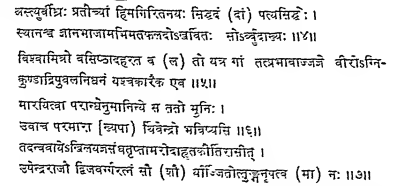
The earliest epigraphic record that mentioned the legend is the Udaipur Praśasti (Fig. 9) of 1072 CE (Epigraphia Indica, vol. I, p. 234) which describes the birth of Upēṇdrarāja who is called ‘dwijavargaratnaṁ’, a clear reference to a brāhmaña:[7]

It is also corroborated in later accounts in Bhōja Paramāra’s time, like ‘Tilakamaṇjarī’ (Fig. 10) of Dhanapāla (as it appears in the ‘Prabaṇdha-ciṇtāmañi’ of Mērutuṇga):
“The Gurjaras on the Ābū mountain still remember the prowess of the king Paramāra, who sprang out of the sacrificial fire pit of Vaśiṣṭha and conquered Viśwāmitra.”

The Aćalēśvara temple inscription at Ābū (Fig. 11) repeats this legend about their origin in the fire pit of Vaśiṣṭha’s sacrifice. (Indian Antiquary, vol. XLIII, p. 193)
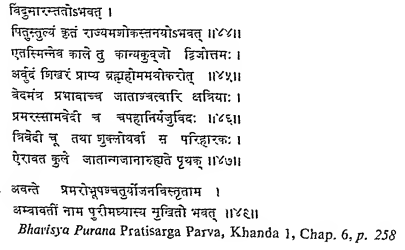
The legend originates in earlier accounts like Bhaviśya Purāña (Fig. 12), which traces Paramāra genealogy back to Aśōka’s time. It speaks of a Kāṇyakubja Brahmin during his reign who performed a sacrifice on the Ābū Mountain to propitiate Brahmā, whereby the power of Vedic chants gave rise to four Kshatriyas born out of that sacrifice, among whom the follower of the Sāmavēda was the Pramāra or Paramāra, who was the ruler of Avaṇtī (present day Mālawa).
This legend of their origin is emphatically stated in numerous Paramāra inscriptions: Nāgpur praśasti of Naravarman (Epigraphia Indica, vol. II, p. 180); Vasaṇtagaḍh Inscription of Pūrñapāla, 1042 CE (Indian Antiquary, vol. IX, p. 12); Mount Ābū inscriptions nos. I and II (Epigraphia Indica, vol. VIII, p. 200), Arathūna inscription of Paramāra Ćamuṇḋarāja (Epigraphia Indica, vol. XIV, p. 295), Paṭṭanārāyaña inscription (Indian Antiquary, vol. 45, p. 77), Mount Ābū inscription (Epigraphia Indica, vol. IX, p. 148), and others like the Pānāhēra, Doṇgaragrāma, and the Jaināda inscriptions.
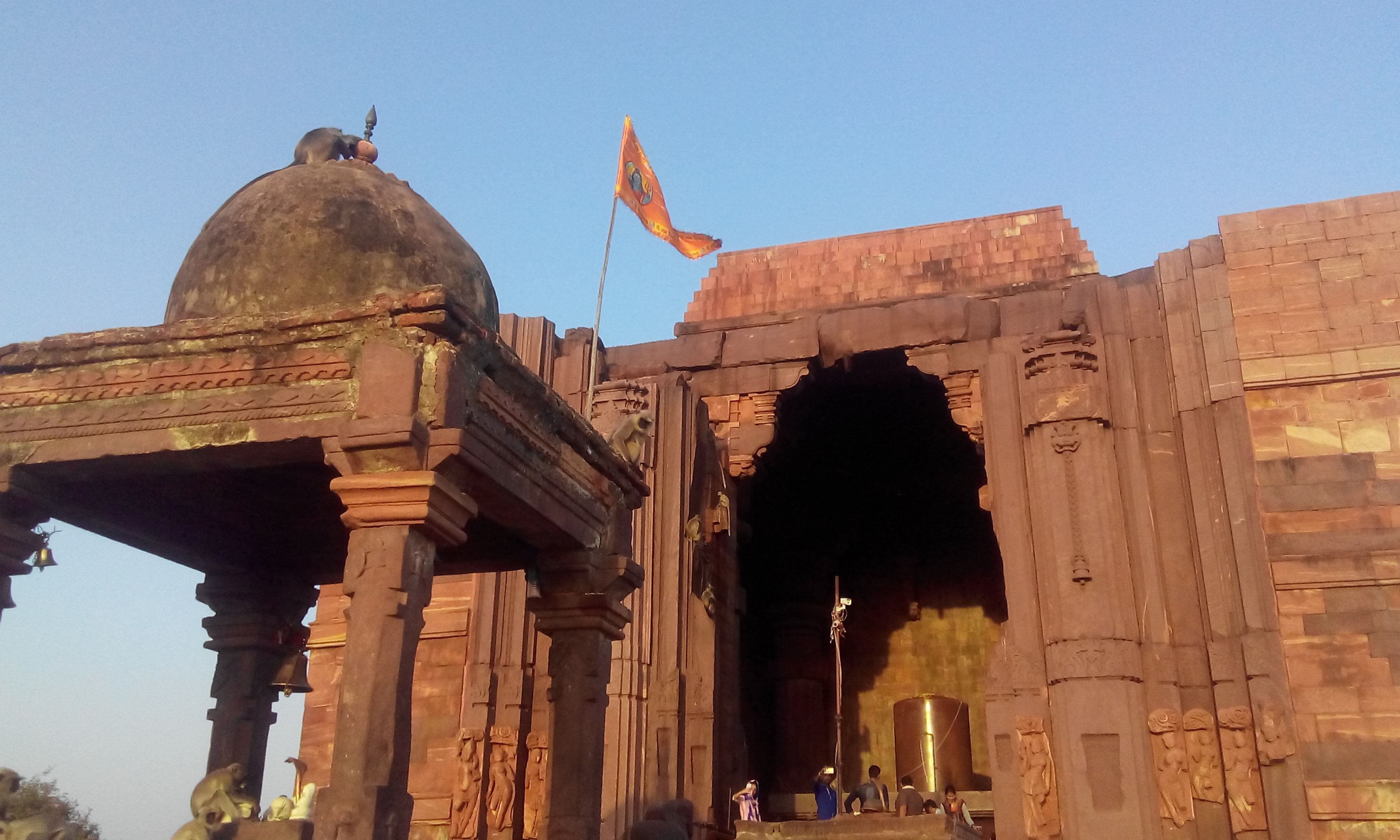
What is important is not whether the agnikula legend is true or not (no man can possibly be born of fire) but that these Rajput clans claimed origin as per the legend, invented stories to associate their lineage with it to show their ascendance and glory, indication of a sensibility completely removed from what caste chauvinists today display. Said Dasharatha Sharma:
“No serious student of history can, of course, believe that fire actually produced warriors. But when one is ready to grant the existence of lunar and solar kśatriyas, the concept of an Agnikula race does not necessarily appear weird and extraordinary and we could easily put the Ćauhāns [or the Paramāras, Pratihāras and Ćaulukyas] among the fire-born septs, if there were any historical warrant for it.” (emphasis added)
The legend also must be seen in the background of the Muslim invasions designed to possibly rejuvenate and rally together the warrior classes, bind the warring clans together, forge kinship and form alliances, to fight for their “dharma and culture”.[8]
But what the agnikula legend also indicates is a close relation between the four clans of Rajputs named in it which becomes apparent as their origins are explored. They all came from the warrior clans who started their career between 550 and 700 CE in Gurjaradēśa, the Gurjara country as described by the Chinese traveller Xuanzang (Yuan Chwang or Hiuen Tsang), of which the pivot was the region of Mount Ābū. The other thing is, even if the legend gives a fictional story it cannot be dismissed in toto as it gives important clues on their likely origin.
Historian Mahāmahōpādhyāya Gaurishankar Hirachand Ojha considers it as certain that the Paramāras sprung from the Mount Ābū region.[9] Importantly, the Pāṭṭanārāyaña temple praśasti in Girwaḍ village in Sirōhī names Dhūmarāja (c. 800 CE) as the founder of the Paramāra line claiming his descent from the sage Vaśiṣṭha.[10] (वसिष्ठ-गोत्रोद्भव एष लोके ख्यातस्तदादौ परमारवंशः) Ojha while rebutting the theory that the Ćauhans, Sōlankīs and Pratihāras had foreign origins, by showing that the agnikula legend belongs to a later period, also declares emphatically that until the 16th century these clans did not consider themselves as agnivaṁshi Rajputs and that at least until the time of Vākpati Muṇja the Paramāras referred to themselves only as ‘brahma-kśatras’.[11]
Bhaṭṭa Halāyudha, the court poet of the Paramāra ruler Vākpati Muṇja II (c. 972-990s CE), in his ‘Mṛtasaṇjīvani’ (a commentary on ‘Piṇgalasūtravṛttī’), without making any mention to the sacrifice of Vaśiṣṭha, refers clearly to the Paramāravaṁśa as ‘brahma-kśatra-kulīnaḥ’[12] describing his patron as a ‘brahma-kśatra’, descended from a Brahmin who had taken to arms (ब्रह्मक्षत्रकुलीनः प्रलीनसामन्तचक्रनुतचरणः । सकलसुकृतैकपुञ्जः श्रीमान्मुञ्जश्चिरं जयति ॥)
Guhilas
The debate on whether the Guhilas originated from a clan of Brahmins or from Kshatriyas has been muddied by the insertion of the idea of their having originated outside India. Having already put that contention behind us (please see annotations under #s 2 and 18), let us look at the evidences from which the varña of the Guhila progenitors may be inferred.
One of the traditions related to the origin of the Guhilas is narrated by Naiñasī, a 17th courtier of Yaśōwantsiṁha Rāṭhōḍ of Mārwāḍ (1629-1678 CE), in his ‘Khyāt’ according to which, the Sisōdiās in the earlier period were known as Gahilots, whose forefather was a king who ruled in the Nāsik-Trayaṃbak region[13], and who used to worship the Sun-god. The King’s son was born after his father got killed in an enemy invasion in the course of which all the people of his kingdom perished. His queen who had been away on a pilgrimage to Aṃbā in Nāgadā that time, gave birth to a son fifteen days later and handed the child over to a Brahmin by name Vijayaditya, with the promise that the child and his descendants would follow Brahminical rites and rituals for ten generations to honour the calling of the foster parents. Consequently, the Sisōdiās came to be known as Nāgadā Brahmins. According to Naiñasī, this son of Vijayaditya was the Gahilot Somadatta, in whose line were born Śilāditya and his progeny.[14]
A similar tradition on the Guhilas’ origin is described by Tod[15], with some variation.[16] Two other literary sources, ‘Rājavilāsa Kāvya’[17] (composed ca. 17th century during the reign of Rāñā Rājasiṁha), and ‘Vīra Vinōd’, by Kavirāj Śyāmaladāsa Dadhivāḍiyā (composed in the second half of the 19th century), reiterate the Guhilas’ connection with the Valabhī kings[18] and suggest their indigenous kśatriya origins, though the name Śilāditya for the ruler after whose death the Guhilas removed to Mēḍapāṭa (Mēwāḍ) does not figure in these.
Abu’l Fazl also records that the Rāñās of Mēwāḍ were known as Brahmins[19] which is consistent with Naiñasī‘s account:
“Having made his head quarters at Sisodā, the tribe is called Sisodiah, and as a Brāhman, at the beginning of their history nurtured their house, they are accounted as belonging to this caste.”
This implies that even in the lifetime of the most celebrated of the Mahārāñās of Mēwāḍ, Pratāp Singh, it was commonly held that the Sisōdiās were of Brahmin varña. He also narrates, among some other prevalent origin-lores about the Sisōdiās, a somewhat different story (which we will not go into here) from the ones narrated by Naiñasī and Tod.
These stories about the dynasty’s origin are as enchanting as they are numerous, and therefore also unreliable, but at the same time largely form the basis of common perceptions among people. Though tradition is an important source of history, the real test of their truth is to be assessed against epigraphical and literary sources authorised by the kings themselves.
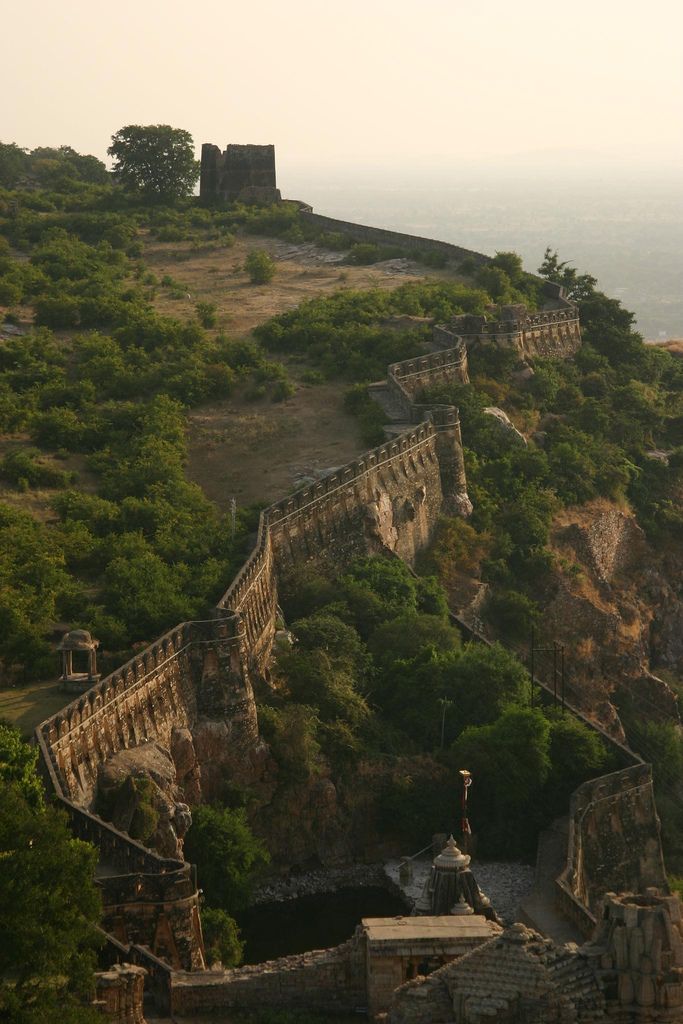
The putative founder of the Guhila family, Guhadatta, is placed chronologically roughly in the last decades of the 6th century based on the Sāṃbhaolī inscription of year 646 CE, by his great grandson Śilāditya. This inscription refers to Śiladitya as the joy of the ‘dēvas and brāhmaña preceptors’ or—depending on interpretation—‘dēvas, brāhmañas and the people’ (देव द्विजगुरुजनान्दो श्रीशिलादित्यो). But whichever interpretation is employed, the word dwija here is clearly taken to mean a Brahmin. His great grandson was Kālabhōja, better known as Bāpa Rāwal[20], who is credited with establishing the kingdom of Mēwāḍ.
However, from epigraphical records it is borne out that it was not before the time of Jaitrasiṁha (1213–1261 CE), as Ćalukyan power waned, that the fort of Ćittauḍ came to be occupied by the Guhilas and thereby their association and identification as the legitimate rulers of Mēḍapāṭa.[21] It is from this time we find that Guhila inscriptions proclaim Śrī Bāpaka (instead of Guhadatta) as the earliest predecessor of the Guhila dynasty.[22] The Śṛngī Ṛṣī inscription of Mokāla, 1428 CE, refers to the Guhila lineage as ‘Bāpajāvaṁśa’.
The forerunner of the Sisōdiā line of the Guhilas was Rāñā Hamīr (b. 1314 – d. 1378).
The Ēkaliṇga-mahātya, authored by Kānhā Vyās, under the aegis of Rāñā Kuṃbhakarṇa, pronounces Vijayaditya, the traditionally acknowledged ancestor of the Guhilas, as vipra[23] and mahīdēva[24] (both words translated straightforwardly, mean ‘Brahmin’) and calls him ‘Nāgarakulanaṇdana’:
“Triumphant are the God Śrī Ēkaliṇga gōtra and the family called Vaijavāpa[25], famed in the world, purifying the people on the whole of the earth, and of magnificence.
Triumphant is the Brahmin (vipra) named Vijayaditya, the ornament of the Nāgara family of Ānaṇdapura (Nāgarakulanaṇdana), a god on earth (mahīdēva), and proficient in sacrificial and other rites. His son was the best of the brāhmañas, Kēśava by name. His son was Nāga Raula and then, Bhōga Raula, Āśādhara, Śrī Dēva, Mahādēva, and after them the ornament of Guhadatta, by whose name this race is still known in the world.
Triumph to Guhadatta, the delighter of the brāhmaña family of Ānaṇdapura (Ānaṇdapuravinirgata viprakulānaṇdaḥ), and the founder of the illustrious Guhila race, spoken of by the poets of yore.”[26] (Emphasis added)
In his composition ‘Rasikapriya’, a commentary on Jaidēva’s ‘Gīta Gōviṇda’, the erudite Rāñā Kuṃbhakarṇa himself refers to his forebear Bāpa as a Brahmin (“dvijapuṇgava” or best among the dvijas) belonging to the Vaijavāpa gōtra.[27]
The Ēkaliṇga inscription of 1489 CE (Verse 12, Bhavnagar Inscriptions, p. 118) calls Bappa a dvija.

The Āṭpur inscription of Śaktikumāra (Fig. 13), 977 CE[28] (Indian Antiquary, vol. XXXIX 1910, p. 186-91) names Guhadatta as the originator of the Guhila line (प्रभवः श्रीगुहिलवंशस्य) and in similar terms as other epigraphs pronounces him to be a Brahmin, calling him not only viprakulanaṇdana (son of a Brahmin family) that came from Ānaṇdapura, but also mahīdēva (Brahmin). The same verse is repeated in the Kadmal inscription of Vijayasiṁha, 1083 CE. These two are the first inscriptions that record a detailed genealogy of the Nāgadā-Āhaḍ (Nāgahṛda) Guhila dynasty of Mēwāḍ.
The Ćittauḍgaḍh inscription of 1409 CE (Verses 9 to 11, Bhavnagar Inscriptions, pp. 74ff) and the Mount Ābū inscription 1420 CE (Indian Antiquary, vol. XVI, pp. 347ff) refer to Bāpa Rawal as a Brahmin. While the first describes him as a ‘vipra’, the second specifically mentions him transforming from Brahminhood to ‘Kshatriya splendour’. The Ćātsu inscription of Bālāditya,[29] 986 CE (Epigraphia Indica, vol. XII, p. 10) mentions their forefather, Bhartṛpaṭṭa, as a ‘brahma-kśatrānvita’ (ब्राह्मक्षत्रान्वितोऽस्मिन् सम्भवदसमे रामतुल्यो विशल्यः । शौर्याढ्यो भर्तृपट्टो रिपुभट विटप् इच्छेद केली पतीयान् ॥) possessing the virtues of brāhma and kśātra, like of Rāma (here: Paraśurāma), repeating the claim to fame of the Guhilas describing Bhartṛpaṭṭa as the slayer of enemies like (Paraśu-)rāma.
This origin claim and lineage of the Guhilas making an analogy with Paraśurāma appears as standard description in a number of epigraphs of successive Guhilas since the 10th century. Historians who preferred the Kshatriya origin view of Guhila Rajputs sought to refute the generally held view that the name denotes Paraśurāma, saying that it could well stand for Rāma of the solar dynasty from whom the Guhilas—began at some point to—claim their inheritance. However, the Ćittauḍgaḍh inscription mentioned above removes every doubt about the identity of the bespoken Rāma, as it mentions Śaktikumāra’s son, Aṁbaprasāda (993–1007 CE) to be the likeness of ‘Bhārgava Rāma’, the lord of the Bhṛgu family, the destroyer of Kshatriyas’ (भृगुकुलपतिरिवद्रित्प्तः क्षत्रसंहारकारि), making it amply clear that the Rāma meant in Guhila inscriptions is Jāmdagnēya Rāma or Paraśurāma, and not Śrī Rāmaćaṇdra of Raghuvaṁśa. It is mystifying that Pt. Ojha makes no mention of this clear reference.
Another of the Ćittauḍgaḍh inscriptions, the Rasiyāki Ćhatri inscription of Samarasiṁha, 1274 CE (Bhavnagar Inscriptions, pp. 74ff), calls Bāpa Rāwal a vipra and states that he obtained, in the shape of an anklet, the splendour of a Kshatriya (kśātra) from the ‘Brahma like sage’ Hārītarāśi, and in return gave up to the sage his devotion and Brahminical lustre (brāhma or merit of Brahminhood) that he obtained as a Brahmin. This interaction with the sage—which is also recorded in the Mount-Ābū Aćalēśvara inscription of 1285 CE—is the means to legitimise the Guhilas role as Kshatriyas[30] and they are subsequently referred to as brahmakśatras (as opposed to the simple description of brāhmaña as for Guhadutta). These are the first set of inscriptions that mention Śri Bāppaka or Bāpa (Mahāraula Śrī Bāpa) as the founder of the House of Mēwāḍ and correspond to the establishment of the Guhilas in Ćittauḍ.[31]
Some writers (Pt. Ojha, C. V. Vaidya. A. K. Vyas and M. L. Mathur) have strained to explain away these references to the Guhila forebears (‘vipra’, ‘dwijapuṇgava’, and ‘mahidēvakulōdbhava’, terms which squarely translate as ‘Brahmin’), and the repeated use of the word ‘brahmakśatri’, by preferring alternative or circuitous interpretations[32]. Ojha also attempts to explain these terms with the legend recorded by Naiñasī, that Guhadatta was brought up by a Brahmin after his father’s death and therefore the first ten generations from himself observed the rites prescribed for the sacerdotal order. Hence, though they were really Kshatriyas in extraction, they were regarded as Brahmins. But the tradition recorded by Naiñasī is very late without a single evidence in the earlier sources and therefore of little probative value. Considering it suggests the Deccan as the Guhilas’ place of origin consistent with the Tuzūk (see note# 13) it appears to have incorporated many later myths.

However, the clinching evidence which none of the earlier writers had access to was found later: a manuscript with the complete text (copied 1670 CE)[33] of the second of the Kuṃbhalgaḍh slabs (Fig. 14), an inscription of Rāñā Kuṃbhakarña, installed in Māmadēva (Kuṃbhasvāmin) temple dated November 3, 1460. The last section of the slab which contains the vaṁśa-varñana (verses 106-111) puts the identity of Bāpa beyond any scope of doubt. It states:
“Bāpa, a highly learned Brahman from Ānaṇdapura[34], left his home with his trusty followers and came to Nāgada in the wild tract of Mēwāḍ. He served Hārīta, who being pleased with him conferred upon him the dignity of a ruler.”[35]
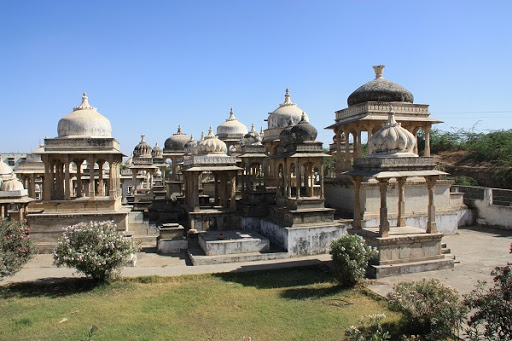
The Aćalēśwar and Ćittauḍgaḍh inscriptions mentioned earlier describe the same event. But the qualifying phrase (विप्र शिप्रतरप्रबोधमधुरातम् दैकनिष्ठम् परम्) introduces Bāpa in a manner which affords no ground for doubting his origin as a Brahmin. It explains why the word ‘vipra’ is used consistently in all references to indicate his origin from a Brahmin line.[36] If in some subsequent epigraphs Bāpa and his successors have been referred to as Kshatriyas, it is owing to the status acquired by the grace of Hārītarāśi. The term brahmakśatrī is therefore used for Bāppa’s successor, Bhartṛpaṭṭa II, in the Ćātsu inscription, indicating they were Brahmins admitted to the orders of Kshatriyas.
The question of Rajputs’ origin is too complicated to be settled within a short simplistic conclusion, but the contents of the above inscription removes all room for interpretation of the words dwija or vipra attempted by Dr Ojha.[37] In the epic age, the function of a Brahmin was both learning and war. Hence, while the term dwija etymologically may mean Kshatriya, and likewise vipra may mean one who sows virtue, it usually means a Brahmin and is used as such.[38] In the quoted verses Hārītarāśi himself is referred to as ‘dwijēndra’. “History of the late early and early medieval times is full of examples[39] of many Kshatriya dynasties which trace their origins from Brahmans.”
The persistence of these writers to prove that the Guhilas descended from pure Kshatriya line brushing aside the obvious epigraphical references to their Brahmin origins, needs treatment at this point. One of its chief proponents, C. V. Vaidya, was of the opinion that only the purest Kshatriya blood flows in the veins of the Rajputs. This was the view of Pt. G. H. Ojha as well. But among Kshatriyas he also included the Kuṣāñas, Śakas, Pahlavas and many other Aryan and non-Aryan groups who, as per him, lost their claim to Kshatriyahood after losing contact with the Brahmins.[40] So instead of rejecting the foreign origin view he actually made a compromise between the two extremities of Tod/Crooke[41] and Vaidya. Ojha tried to support his view about the pure Kshatriya descent of Rajputs quoting Manu’s word, that the Pauṇdrakas, Ćolas, Draviḍas, Kaṃbōjas, Yavanas, Śakas, Paradas, Pahlavas, Chīnas, Kirātas and Daradas were ‘fallen Kshatriyas’ who sank to the condition of śūdras as a consequence of omission of the sacred rites and remaining away from the brāhmañas[42]. Needless to say, such supposititious claims go beyond the sphere of valid historical testimony and reasoning.[43] It is unimaginable that the Chīnas or Śakas could ever have been originally ‘Brahminical Kshatriyas’! The Mahābharata lists many of these tribes as non-Ayrans, and in the Mahābhāṣya, the Śakas and Yavanas are named as śūdras. Fact is, that many warrior clans from among foreign groups were continually absorbed in the Hindu social order down the ages. The Rajput lineages descended from Ilā and Ikśvākus too must have continued (when other castes survived, the Kshatriyas need not have disappeared). But, irrespective of the specific question of the Sisōdiās, the suggestion of pure Kshatriya lineage of all Rajputs is by itself ridiculous.
We go over some of the arguments on which Pt. Ojha based his theory:
As one of the evidences he drew attention to was a gold coin[44] on which he read the legend Śrī Voppa on one side and on the reverse, several symbols, among them one which is taken to represent the Sun. Pt. Ojha attributed the coin to Bāpa and further urged that the Sun is indicative of his solar lineage of the Epic and Purāñic fame. But the reading of the legend on this coin as ‘Śrī Voppa’ is considered flawed by experts.[45] Moreover, none of the coins were found anywhere within the limits of Mēwāḍ. Inferring a link to the Guhilas is tenuous at best, much farther to their supposed Suryavaṁśī lineage from it. There is no evidence whatsoever that the princes of Guhila family ever used gold for their coinage. Also, the appearance of Sun on the coin of a particular ruler does not necessarily prove descent from the solar family.
Ojha’s second argument was based on the Ēkliṇgji Inscription of Naravahana, 971 CE, placed in the Lakulīśa temple (also known as ‘Nātha Praśasti’). He held that the sages of the Lakulīśa-Pāśupāta sect (the ascetics of Ēkalinga, whose successors officiate as the priests of the deity and act as preceptors of the Guhilas) have been described therein as Raghuvaṁśakīrtipiśuñāḥ (the acclaimer of the fame of Raghuvaṁśa from the Himālayas to Sētubaṇdha Rāmēśvara), which in fact must represent the glory of the Sisōdiā line of kings.[46] Bhandarkar had edited this inscription in Journal of the Bombay Branch of the Royal Asiatic Society (Vol. XXII, pp. 166ff) to read: “योगिनः सापानुग्रहभूमयो हिमशिला बन्धोज्ज्वलादागिरेरासेतो रघुवंशकीर्तिपिशुनात्रिव्रं तपः…” (in which the phrase ‘रघुवंशकीर्तिपिशुनात्’ ends with the fifth-case ending, which, in his mind, could not be taken to qualify the word ‘योगिनः’ and therefore translated it to qualify the word ‘आसेतो’). Bhandarkar left a note suggesting this emendation of the word ‘पिशुनास्तिव्रं’ with ‘पिशुनात्रिव्रं’, which Ojha and Vaidya both accepted[47] but were dissatisfied with his interpretation on the subject it predicated. The same epigraph can be found in another publication, ‘Bhavnagar Inscriptions’ of Peter Peterson, from which we get the reading ‘रघुवंशकीर्तिपिशुनात्तीव्रं’ (approximate to ‘रघुवंशकीर्तिपिशुनात्रिव्रं’), which also ends with the fifth-case qualifying the word ‘आसेतो’. There can be no doubt therefore that this is the correct reading which refers to the bridge in the South (sētu) as the mark of glory of Śrī Rāmaćaṇdra of the Raghu family.[48] Ascribing the fame of Raghukula to the Lakulīśa sages and through them transposing it to the Sisōdiās is indeed a wide stretch!
Ojha (and Mathur, whose litany was a mere repetition of Ojha) put forth a third argument based on the 977 CE Āṭpur inscription, which describes Naravāhana as ‘kśatrakśētraṁ’. The term was interpreted by him to mean ‘क्षत्रियों का क्षेत्र’ or ‘क्षत्रियों का उत्पत्तिस्थान’, the provenance of the Kshatriyas. But this is again modification of the exact word to suit a preset purpose. More precisely translated the word would simply mean ‘the repository (kśētra) of marital prowess (kśātra)’ or the field of action of Kshatriyas where the Guhilas distinguished themselves. The attribution to a ‘place of origin’ is simply absent and forced by Ojha. The origin of Kshatriyas moreover cannot be said to be localised to a specific place. He also cites the association of the Sun with Bāpa in this inscription to reinforce his view about the origin from the solar lineage. But this too is a weak argument as the term used therein is ‘Arkasama’ (meaning resplendent as the Sun), not as belonging to Arkakula or Sūryavaṁśa or Saptāśvavaṁśa.
Conclusion:
The earliest mentions of the Guhila rulers to their roots contain none of the claims of prestigious origins but simple expressions like ‘Guhilānvaya’[49], ‘svakulāṃbaraćaṇdramāḥ’[50], without any reference to their varña. This is sometimes pointed to as making the Brahmin origin of the Guhilas uncertain. But by no means within the Hindu varñāśrama can non-Brahmins be made Brahmins, or claim Brahminhood for themselves, or the descendants of Kshatriyas become Brahmins, or that they shift back-and-forth from Kshatriya to Brahmin and then again to Kshatriya. (Clearly the use of a lot of imagination to reconcile epigraphic evidence with Naiñasī’s lore! One however that is wholly inconsistent with shastraic injuctions as well as contemporary practice.) If the Guhilas called themselves Brahmins in 977 CE, their forefathers would have to be Brahmins too. Neither would the need arise for calling themselves brahmakśatrī unless they, at least in some part, derived descent from Brahmins, or were previously Brahmins who took to arms and saw this status as a means to promulgate the new vocation. In case of the Guhilas, unlike the Pratihāras, since there is no claim, neither legendary nor factual, to have originated from a mix of the two castes, only the latter explanation can possibly apply, that they descended from Brahmins. And within Guhila inscriptions we find clear references which explain this transition as stemming from the benediction received from the Pāśupata sage Hārītarāśi. Needless to say, there would be no reason to call themselves brahmakśatrīs had they been pure Kshatriyas.
From 10th century onwards we find numerous inscriptions describing their origins from an esteemed line of Brahmins, references to which we find right up till the 16th century. This indicates a coming to prominence of the family and the need to proclaim their antecedents. Many of the subsequent epigraphs also describe them as brahmakśhatrīs indicating they took to arms having belonged earlier to the sacerdotal order.
It is not until the 13th century that we find references in some of the epigraphs in which the Guhilas call themselves Kshatriyas, e.g., the Ćittauḍgaḍh inscription of 1278 CE[51], in which the Guhilas (Guhilaputra Siṁha) are called Kshatriya, and the 1428 Śṛngī Ṛṣī inscription of Mokāla[52], in which Kśētrasiṁha is described as ‘kśētra Kśatriyavaṁśamaṇḋanamañi’ or the jewel adorning the Kshatriya race. This indicates a stage in their history when the Guhilas established themselves among the class of rulers, which was in fact the case, as it was in this period that Jaitrasiṁha (1213-1261 CE) captured Ćittauḍ fort and the family were catapulted from being feudatories of the previous potentates (a later Mauryan dynasty) to the status of rulers of Mēwāḍ.
But for finding a trace of solar lineage one must travel ahead to a much later period in the time of Mokāla when we find the first fragmentary inscription[53] which refers to Saptāśvavaṁśa (i.e. the Solar line) of the Guhilas, the ‘head of the princes’. In the Nādalāi Ādinātha temple inscription of Rāimala, of 1500 CE[54] we find the first reference to the Guhila forebears Guhadatta, Bāpa and Khummāña as Sūryavaṁśī kings (सुर्यवंशीय महाराजाधिराज श्री शिलादित्यवंशे). As ruling families in the past are known to have constructed elaborate genealogies to trace their line to legendary characters of puranic fame in order to assert the ascendancy of their house, this point needs no elaboration. There are some sources which also hint at a connection with the lunar lineage (in the Nādalāi inscription, one of the Guhilōt princes is called ‘mṛgāṇkavaṁśadyōtakāraka’; a later tradition linking the Guhilas to the Paurava family—a lunar lineage according to some Purāñas—is recorded by some 17th century writers like Thomas Roe and François Bernier).
But the central point is: the Sisōdiās are not known to have ever abjured their Brahmin roots. Rāñā Kuṃbhā had no hesitation in calling Bāpa a Brahmin in his ‘Rasikapriya’. The Guhilas’ Brahmin origins was a fact both officially stated and popularly known. It is noted in their inscriptions, from Āṭpur inscription, 977 CE (विप्रकुलनन्दनो महीदेव), Ćātsu inscription, 986 CE (ब्रह्मक्षत्रान्वितो … भतृमहो), the 1274 CE Rasiyāki Ćhatri inscription (यस्याः आगत्य विप्रः खपुरदधिमटीवेदिनिक्षिपायुगो । बापाख्योवीतरागश्वरणयुगमुपासीत हारीत राशैः ॥) and Rāyamal inscription, 1488 CE (श्रीमेड़पाटभुविनागह्यदेपुरेनूद्वाष्यो द्विजः); and recorded in literary works (in Ēkaliṇga-mahātmyaṁ[55], Naiñasī quoting a ćhappaya[56], and stated in Rañćhōḍa Bhaṭṭa’s[57] ‘Rājapraśasti’[58].)
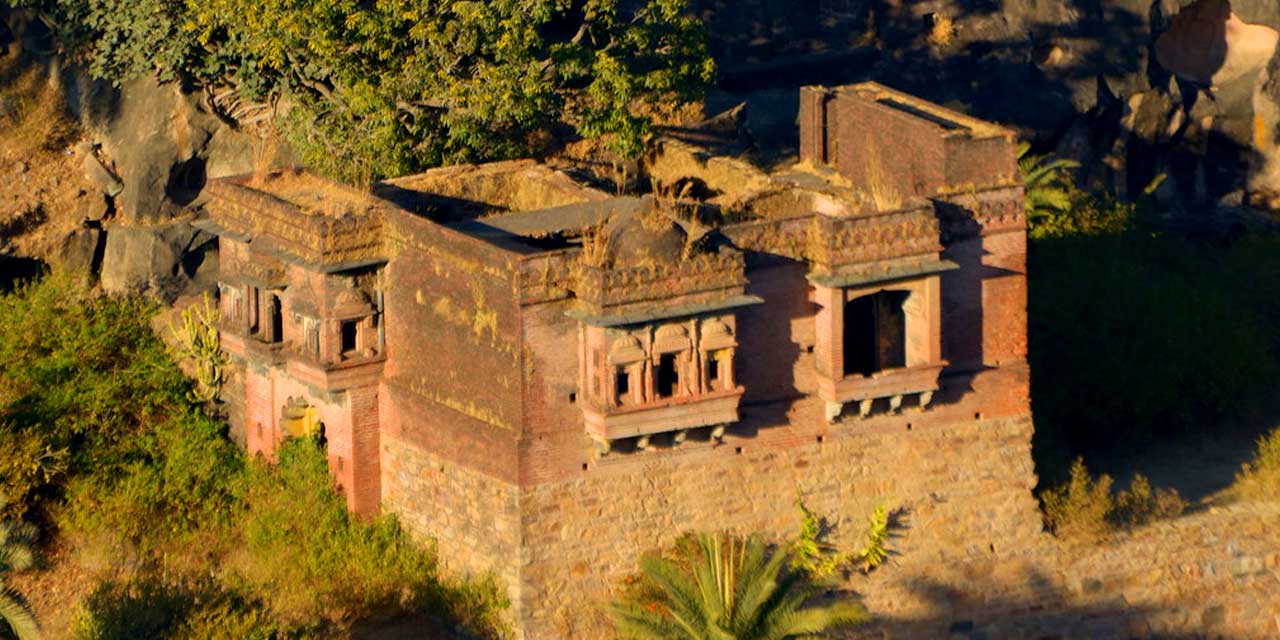
Apparently, the priestly function once exercised by the Mēwāḍ Rāñās’ ancestors survived until recent times. We are told by Tod that “the Rāṇā of Mewar mingles spiritual duties with those of royalty, and when he attends the temple of the tutelary deities of his race he performs himself all the offices of the high priest for the day. The Rāṇā is called ‘Ekaliṅga ka Dewān’.”[59]
Another 19th century work, Tarīḳh-i-Mālawā, by Munshi Karimuddin, makes a reference to the Brahmin origin of the Guhilas.[60] As late as the 20th century Maulvi Abdul Farhati in the time of Rāñā Fateh Singh states in his ‘Tōhfāh-i-Rājasthān’ that the Rāñās of Mēwāḍ were originally Brahmins. Unfortunately, the book was proscribed by the then Governor of Mēwāḍ, and the damage to the second slab also appears part of a deliberate action of some people who did not like to see that such record exists.[61] This is the same kind of fanaticism pointed out at the beginning of this article in suppressing the facts about the origin of several of the Rajput clans in order to preserve the deliberately constructed fiction of their caste purity. This is very similar to the bigotry with which Sikhs attempt to forge separateness from Hinduism.
There are a million such notional spheres with which Indians identify themselves and seek validation when they interact in the social media world, each with their set of drivers and triggers, but few with a basis in genuine sources of knowledge. What is truly missing among Indians (still!) is the bigger picture which few ever grasp.
We will look at some more fascinating stories of the origins of some of India’s ruling dynasties in subsequent sections of this series.
Cover Picture: Kuṃbhalgaḍh Fort (Source: Civitatis) Featured Image: Ćittauḍgaḍh Fort (Source: Wiki)
[1] By this view the so-called Agnivaṁśī clans were foreigners admitted to the Hindu fold after undergoing a rite of purgation by fire.
[2] The 18th century ‘Ma’āsir-ul-Umāra’, of Samsam-ud-Daula Shah Nawaz Khan and Abdul Hai Khan, mentions that ‘the Guhila dynasty was descended from the family of Noshirwan-i-Ādil, the emperor of Iran.’
This is repeated in ‘Bisāt-ul-G̣anīm’ (1790) of Lakshminarayan Sufi Aurangabadi (‘Annals and Antiquities of Rajasthan’ I, p. 275 ff – James Tod): “They [Rāñās of Mēwāḍ] deduced their origin from Noshirwan-i-Ādil, who conquered many parts of Hindustan. Noshirwan married the daughter of Keshar of Rum. His son by that wife was Noshizad, who came with a large force to India. Later, he attacked his father in Iran, but was killed. His descendants remained in India and were known as the Ranas of Mewar.”
These works only record an origin-myth prevailing from earlier times about the Sisōdiās. As early as the 16th century, Abu’l Fazl mentions the talk of the Sisōdiās having originated outside India, but brushes it aside condescendingly. (“He is of the Ghelot clan and pretends a descent from Noshirwan the Just.” – ‘A’in-i-Aḳbari’ II, p. 35 (Jarett, tr.)
This story was apparently related to Col. Tod as well by Jai Singh of Aṃbēr. This shows that the talk of the Sisōdiā’s foreign origins was so widely prevalent as to have caught the attention of Aḳbar’s official chronicler. Tod, on the basis of the legend on Sisōdiā origins, said that not the male line of the Rāñās was of foreign origin, but a former matriarch, Mahabanu, the fugitive daughter of Yezdegird of Persia who arrived in India (another prevalent legend of the times) and married the ruler of Sauraśtra. She was according to him Śubhāṇgana, the mother of Śiladitya. (The legend of Śubhāṇgana, in turn, we find recorded in ‘Upadēṣa Prasāda’, an anthology of historical fragments in the Magahī dialect, which says that she was the daughter of a Brahmin Dēvādit of Kairā in Gujarat.)
These legends may have been strengthened on the basis of the Āṭpur inscription of 977 CE, which mentions a Huña princess, Haritadēvī, married to one of the Guhila scions, Allaṭa. (Epigraphia India, vol. XXXIX, p. 191, verse 5)
[3] Devadatta Ramakrishna Bhandarkar in ‘Foreign Elements in the Hindu Population’ Journal of Ancient Indian History, vol. I, parts 1-2 (1967-68), p. 69
Though his averment about the extent of “admixture of alien blood” in Indians may be questioned, as Indians of all castes have historically shown an aversion for diluting the bloodline through foreign infusion, the idea of caste as the basis of racial purity is ill-founded, as modern genetics has shown.
[4] The Pratihāras of Ujjain in contrast proclaim themselves to be Kshatriyas. Vatsarāja, the grand nephew of Nagabhaṭa-I, is mentioned as (ēkaḥ kśatriya puṇgavēṣu – ‘foremost among the most distinguished Kshatriyas’; and his son Nagabhaṭa is said to have ‘…performed the religious rites according to kśatriya families’ (kśātradharma vidhi vaddha bali prabaṇdaḥ).
[5] Though in the Vedic period kśatriyas were known to have become brāhmañas, in the subsequent period this was not very common, and brāhmañas descending from kśatriyas is unheard of in Purāñic accounts.
[6] K. M. Munshi (‘The Imperial Gūrjaras’ in ‘The Glory that was Gūrjara Deśa’)
[7] “An important point, which deserves attention is that there is a marked difference between the uses of this term [dwija] in the official epigraphic records and the Smritis respectively, as in the former it has invariably been used in a restricted or an orthodox sense, i.e. to denote only a Brahmana.” (‘Origin of the Paramaras’, Dr K. N. Seth)
Among the examples cited by Seth is the Kanaswa Inscription of Sivagana, V.S. 795 (=A. D. 738), which mentions Saṇkuka, a brāhmaña prince, taking as his lawful wife, Dēginī, also sprung from a brāhmaña family, as: “Dēginī namatasy=āsīd=dharmma-patni dvij–ōdbhava”.
Similarly, the Jōdhpur Inscription of the Pratihāra Bāuka, V.S. 894 (=A.D. 837), names an illustrious brāhmaña Harićaṇdra (vipraḥ Śrī Harićaṇdra) as their progenitor of his line, who married first the daughter of a brāhmaña as: “tēna Śrī Harićaṇdrēna pariñītā dvijātmajā”. In contrast, his Kshatriya wife is mentioned as: “dwitīya kśatriyā bhadrā mahākulaguñānvitā” ([married] secondly the virtuous high-born Kshatriya lady Bhadrā). (Please see transcription of inscription above in image 2).
Again, Harśarāja of the Guhilas of Dhavagarta (Dhōḍ), the ruler of Ćitrakūṭa (Ćittauḍ) is mentioned in the inscription of his great-grandson as a dvija, i.e. Brahmana. Whenever the first three higher castes were to be mentioned in any royal grant or inscription, they are not referred to collectively by the use of the word ‘dwija’, but each of the three castes is denoted separately. As in the Ghatiyala Pillar Inscription dated V.S. 918 (=A. D. 861) which tells us that Kakkuka, the favourite son of the Pratihāra Kakka, constructed a market place and peopled it only with Brahmins, Kshatriyas and Vaisyas forming the ‘big folk’ (“विचित्रवीथिसंपूर्ण हद्दं कृत्वा गृहाणि च । विप्र-वणिग्-प्रकृतीनां गृहं गत्वा प्रियेण च ॥ श्रीमत्कक्कस्य पुत्रेण, सत्प्रतिहारजातिना । ककुक्केन स्थितिं दत्वा स्थापितोत्त्त्र महाजनः ॥”)
It may reasonably be presumed therefore that Upēṇdrāja mentioned here was a Brahmin and the expression ‘dvijavargaratnam’, applied to him in the Udaipur praśasti, may be taken to mean ‘a jewel among brāhmañas’. (Seth)
[8] ‘The Paramaras’, by Pritpal Bhatia
[9] ‘राजपूताने का इतिहास’, जिल्द पहली, by G. H. Ojha (पृ. १९१) ‘मुहणोत नैणसी री ख्यात’, vol. I, p. 234
[10] (अनीतधेन्वे परनिर्जयेन मुनिः स्वगोत्रं परमारजातिम् । तस्मै ददाबुद्धतभूरिभाग्यं तं धौमराजं च चकार नाम्ना ॥)
[11] Ojha (‘राजपूताने का इतिहास’ जिल्द पहली, पृ. ७६)
[12] 1) Ojha (‘राजपूताने का इतिहास’ जिल्द पहली, पृ. ६६) 2) C. V. Vaidya attempted to explain this term as meaning, the Paramāras were “Kshatriyas who were endowed with brāhma, i.e. who had kept up their connection with the Vedic Rishis”. This however is untenable as by the time of Muṇja Vākpati-ll, i.e. the last decade of the tenth century CE, the Kshatriyas had lost importance for their gōtras, if they had not forgotten them, a fact which is generally accepted and acknowledged by Vaidya. (‘History of Medieval Hindu India’, vol. II, by C. V. Vaidya (p. 62)) Their gōtras are not indicative of their progenitors but are that of their purōhitas, and sometimes with the change of purōhitas, their gōtras too changed. The explanation fails in the face of this fact as it is impossible to keep contact with the pravara hṛiṣīs if they did not retain their own gōtras. It is notable that Paramāras all over India carry a single gōtra and pravara, i.e. Vaśiṣṭha, which is characteristic of the Vaśiṣṭha gōtra (ब्राह्मणभाइलाय वामानसुताय वशिष्ठसगोत्राय । वाजिमाघ्यंदिनशाखायैकप्रवराय ॥) (‘The Growth of the Paramara Power in Malwa’, Dr K. N. Seth)
[13] The Tuzūk-i-Jahāṅgīri also makes an allusion to the Guhilas having their kingdom originally in the Deccan. (Tuzūk-i-Jahāṅgīri I, Rogers and Beveridge, tr., p. 250) Abu’l Fazl points this place to be Berar (A’in-i-Aḳbari, part II, p. 35 – Jarett, tr.)
[14] Khyāta-I (R. Dugada, tr.) pp. 10ff n.
[15] ‘Annals and Antiquities of Rajasthan’, vol. I, by Col. James Tod (p. 266)
[16] According to this version, the rulers of Mēwāḍ were from the Raghuvaṁśī section of the solar race through Sumitra, Kañaksena and Śilāditya, the last Valabhī king of Gujarat, and ranked as the first of the thirty-six Rajput tribes. Kañaksena is said to have come to Saurashtra from Lōha-Kōṭa or Lahore, and dispossessing the Paramāra king found a city in 144 CE called Vīranagara. Four generations after him, Vijayasēna founded Vidarbha and Vijayapura in Saurashtra while retaining his capital in Valabhī. His descendant, Śiladitya, faced an invasion from barbarians, the date for which as given by Jain sources is 524 CE, during which Valabhī was destroyed and the king along with all his subjects were killed. His queen, Puśpavatī who had gone on a pilgrimage to Aṃbā Bhavānī, survived, and a few days later gave birth to a son in a cave in the Mālliā mountains where she had taken refuge, who thus came to be known as ‘Guha’ or ‘cave-born’. A Brahmin lady of Vīranagara called Kamalāvatī, reared this child, who subsequently became the king of the Bhīls of this region. Nāgaditya, the eight in this line of kings, which came to be known as Guhilas after Guha, was a despotic ruler and consequently overthrown and killed. His young son, Bāpa, was removed by the descendants of Kamalāvatī, who became the hereditary priests of Guhilas, to the safety of a place in a hilly region called Nāgīṇdra (modern Nāgadā near Udaipur). Growing up there among nature, one day while tending cows, he met the sage Hārīta, who was a devotee of Ēkaliṇga Mahādēva. He became a disciple of Hārīta and from him obtained a boon of invincibility. Thereafter, he entered the service of his uncle, Mana, who was the Mori king of Ćittauḍ, whom he subsequently deposed and “took Chittor from Mori and became himself the ‘mor’ (crown) of the land. He obtained by universal consent the title of ‘Sun of the Hindus’ (Hindu-suraj), preceptor of princes (Raj Guru) and universal lord (Chakrawartin).” And thus was laid the foundation of the Guhila dynasty of Mēwāḍ.
[17] ‘Rājpūtāne kā Itihāsa’, vol. I, by G. H. Ojha (p. 388)
[18] Bhandarkar’s error sprung from this connection between the Mēwāḍ and Valabhī dynasties prevalent in tradition, and in turn associating Valabhīs with the Maitrakas, and confusing Maitrakas, along with the Nāgara Brahmins—since many of the Nāgara Brahmins carry the last name ‘Mitra’, he took them to be related—to be the same as the ‘Mihira’, ‘Meher’, or ‘Mēḍ’ people, a tribe of Kāṭhiawāḍ region said to be of foreign origin. The mistake was on account of a misreading of a copperplate grant attributed to Bhaṭṭārka, a military governor of the Guptas. This confusion was compounded all the more as there is a Bhāṭṭa caste in Mēwāḍ, who have Ēkaliṇga as their family deity, and claims relations to the Bhāṭṭas of Valabhī, and that they migrated from there to Mēwāḍ along with the ancestors of the Rāñās. (The Fragmentary Second Slab of Kumbhalgarh Inscription, V.S. 1517 and the Origin of the Guhilots in ‘Glories of Mewar’, by Dr G. N. Sharma) There was another obvious flaw, that, even though Brahmins are known to have mixed with other castes, no foreign group could possibly have been ever admitted into the brāhmaña varña. Further, the Nāgara Brahmins of ‘Vaijavāpa’ gōtra, which we learn from Ēkaliṇga-mahātmya, was the Sisōdiā’s gōtra, carried the lastname ‘Āditya’.
But importantly, Bhandarkar later revised his view about the Maitrakas. (“As the Nāgar Brāhmin origin of the Guhilas is not free from doubt, the question of their ethnic affiliation with the Mers and the Huns does not arise at all. Dr. Bhandarkar also admits that with regard to this particular part of his thesis he is not on terra firma.” – ‘History of Mewar’, G. C. Raychoudhuri, p. 229, n. 36)
[19] ‘Sūbāh-i-Ajmēr’ in Ā’īn-i-Aḳbari II, p. 269
[20] This too is not a settled question, as according to many historians, ‘Bāpa’ is an appellation for a father figure, with many contradictory, intersecting and equally plausible bits of information from various inscriptions about who Bāpa was. We go here with the assertion of Pt. Gaurishankar Ojha who identified Kālabhōja with the Guhila progenitor, Bāpa Rāwal (‘उदयपुर राज्य का इतिहास’, पृ. १०२-१०४)
[21] 1) Ojha (‘उदयपुर राज्य का इतिहास’, पृ. ६६-६७) 2) G. C. Raychaudhuri (‘History of Mewar’, p. 31) 3) Dr Dasharatha Sharma (ed.) (‘Rajasthan Through The Ages’, vol. I, p. 240)
[22] ‘A Study of the Origin Myths Situating the Guhilas in the History of Mewar (A.D. Seventh to Thirteenth Centuries)’, by Nandini Sinha
[23] This word may be interpreted to mean a ‘sage’, ‘virtuous’ or a ‘wise man’, but these are at best alternative explanations without occasion for their use in the present context. Vipra certainly denotes a person with these qualities but it is for all purposes used only for Brahmins (‘vipra-varña’, ‘vipra-kula’, etc.) The word ‘vipraka’ denotes a petty or a contemptible Brahmin, and ‘vipratā’ the state of being a Brahmin. Even if one must limit the term ‘vipra’ by its academic meaning to imply merely a wise or learned man, used in conjunction with ‘kula’ (viprakula, or a family of viprāḥ) it can mean nothing but a Brahmin, since there is no way the whole lineage of a king can be termed as ‘vipra’. Likewise, the word ‘mahīdēva’ used in reference to Guhilots is combined with ‘kulōdbhava’ (mahīdēvakulōdbhava, or born of a family of mahīdēvāḥ), which can only denote a Brahmin. (In the keenness to justify their episode the Kshatriya origin lobby was clearly not thinking straight!) Most of all, none of the scholars who preferred this interpretation could provide a single instance from entire Sanskrit literature where vipra has been used to denote a non-Brahmin.
[24] The suggestion of some of the ‘Kshatriya origin’ theorists that the word mahīdēvaḥ means a ‘king’ and not a brāhmaña, is difficult to accept. Its use to denote the former is unknown in Sanskrit literature as well as epigraphic records, which make a clear distinction between ‘mahīdēva’ (Brahmin) and ‘naradēva’ (king). (Raychoudhuri, ob. cit.) An alternative word is mahīsura both of which are used as synonyms for the word brāhmaña.
[25] “श्री एकलिंगदेवेन् गोत्रं वैजवापहं”
[26] यदुक्तं पुरातनै कबिविः, आनन्दपुर समागता, विप्रकुलनन्दन महीदेव ।
जयति श्री गुहदत्त, प्रभवः श्री गुहिल वंशस्य ॥
[27] J.A.S.B. (1909), p. 173
[28] In a paper contributed to Indian History Quarterly (‘Origin of the Guhilots: were they Nagar Brahmins?’, IHQ Vol. XXVI No. 1 March 1950, pp. 263-276), M. L. Mathur commenting on the Āṭpur inscription concurs with Ojha that the word mahīdēva in these inscriptions could well mean ‘king’, use of the word dēva for king being common in Sanskrit dramas and epics. If it were to mean a Brahmin its use along with vipra amounts to a “superfluous duplication”.
In an acute rebuttal to his rather glib surmises, Malati Sharma wrote (‘Origin of the Guhilots’, IHQ Vol. XXVIII No. 1 March 1952, pp. 83-86) that there is no psychological inconsistency in regarding a Brahmin as a source of delight to a Brahmin family. The words mahīdēva and dēva treated as synonyms by Mathur amounts to a feint since they are not identical, and he was at liberty to quote even a single instance from the vast body of Sanskrit works where the two words are used interchangeably to mean a king. In Sanskrit and all affiliated languages, the word mahīdēva occurs only in reference to a Brahmin, as it is a yōgarūḍha word. Even if mahīdēva is literally translated, the word means ‘a god on earth’ which would not render the meaning of the sentence any different.
[29] S/o Bhaṭṭa s/o Guhila II s/o Harsha of the Guhilas of Dhoḍ (Ćitrakūṭa or Ćittauḍ)
[30] 1) ‘उदयपुर राज्य का इतिहास’, प्रथम खण्ड – रायबहादुर गौरीशंकर हीराचंद ओझा (पृ. १७६) 2) “नागदा नगर के सम्बन्ध में हारीत ऋषि का वर्णन आता है जिन्होंने यहाँ घोर तपस्या की थी । इन्हीं की अनुकम्पा से बापा को राज्य प्राप्त हुआ और क्षत्रियत्व की प्राप्ती हुई ।” (‘राजस्थान के इतिहास के स्त्रोत’, डॉ. गोपीनाथ शर्मा)
हारीतात्किल बप्पकोअध्रिवलय व्याजेन लेभे महः ।
क्षात्रंधातृनिभाद्वितीर्य मुनये ब्राह्मं स्वसेवाच्छ्लात् ॥
एते अद्यापि महीभुज क्षितितल तद्वश संभूतयः ।
शोभंते सुतरामुपात्तवपुष: क्षात्राहि धर्मा इव ॥११॥
(तिथि: वि.सं. १३४२ माघ शुक्ल १)
[31] Nandini Sinha, ob. cit.
[32] As ‘evidence’ in support of his case, that the word vipra does not necessarily mean a Brahmin by birth, Mathur brought in Swāmī Dayānanda Sarasvatī’s unorthodox views. But the fact is, Dayānanda considered no one a Brahmin or Kshatriya at birth. He ignores the premise of Dayānanda’s expansive work that lay in the concepts of jāti brāhmaña, guña brāhmaña and karma brāhmaña, which renders the very basis of the present debate infructuous. This exegesis has no bearing on the conventional and specific use of the word in texts, epigraphy as well as common terms of reference, whereby it singularly denotes a Brahmin.
His statements are moreover contradictory as the same word as occurring in viprakulanaṇdano (विप्रकुलनन्दनो) is interpreted by him as meaning a Brahmin. However instead of taking the word kulanaṇdana for what it would usually imply (a scion or child of the family) Mathur chose to apply a literal interpretation, contending that the line just points to Śiladitya being the ‘delighter of the Brahmin family’ that sprung from Ānaṇdapura.
The terms ‘Raghukulanaṇdana’ and ‘Daśarathanaṇdana’ cannot be interpreted to mean merely a ‘delighter of the Raghu family’ because then it could stand for anyone. It cannot be taken to mean anything but Rāma, the most illustrious scion of the Raghu family and the son of Daśaratha respectively. The word ‘viprakulanaṇdana’ in the verse can hence only mean a son or an illustrious scion of the Brahmin family from Ānaṇdapura. Why would, besides, a certain Brahmin family from Ānaṇdapura be so important that even the king derived fame from its mention, except the consequence that he actually came from that family?
[33] M.S. entitled ‘Prashasti Sangraha’ of Saraswati Bhawan Library, pp. 73-74 (Dr. G. N. Sharma, ob. cit.)
[34] This place, according to G. N. Sharma, is identified on the basis of ‘Amarakāvyavaṁśāvalī’ (चित्रकूटस्य निकटे आनन्दिपुरनामकं पुरं पुरासीन्ह अधुना अरुणादाभिधानः) as modern day Arnoḋa near Ćittauḍ. (ibid.) This agrees with C. V. Vaidya’s view that Ānaṇdapura is to be identified with Nāgahṛda, modern Nāgadā near Udaipur. He in turn cited the Ćittauḍgaḍh inscription of 1274 CE (इलाखण्ड अवनिभूषणः (verse 8) जीयद आनन्दपुरम् तद् इह पुरं इलाखण्डसौन्दर्यशोभि) whereby ‘iha’ indicates that Ānaṇdapura was within Mēwāḍ. The verse describes both Ānaṇdapura and Nāgahṛda as ornaments of Ilākhaṇḋa implying they were probably in the same part of the country (अस्ति नागहृदनम् सायं इह पट्टनम). This view is further supported by the fact that Āhāḍa, ancient Āghāṭa, was known as Ānaṇdapura. (Asiatic Researches, vol. II, p. 912)
[35] Ibid. (हारीतराशिमुनियुगवपादमद्यसेवाप्त सभ्यगप्रसादवरप्रसादः)
[36] G. N. Sharma, ob. cit.
[37] Ibid.
[38] Ibid. (See also Note# 7) Interestingly, Dr M. L. Mathur himself translates the word dwija as Brahmin in the phrase ‘dwija-guru-jana’. (IHQ Vol. XXIV, p. 274) The word dwija occurs repeatedly in Guhila inscriptions itself to denote exclusively a Brahmin. In a 688 CE copper plate grant of Bābhaṭa, of the Kiṣkindhā branch of Guhilas, two words, ‘dwijagaña’ and ‘dwijavasatiḥ’, occur in reference to Brahmins. It is used in the same sense (‘dwijajanasya’) in the 944 CE Āhāḍ inscription of Bhartṛpaṭṭa. The 953 CE Sāranēśvara temple inscription of Allāṭa names one Vasantarāja among the members of the temple committee, prefixed with dwija, to the exception of the other members, which includes, among others, Allāṭa himself and his son Naravāhana. If the term were to denote ‘twice-born’ in the sense of the Smṛtis, this would mean that all the other members of the committee were Shudras, including the king and his son! An impossibility, to say the least.
[39] Mirashi Vakataka Ins. Cave XVI at Ajanta, at Hyderabad, Arch Series No. 14, p. 10; Deopara Praśasti Epigrahia Indica I. pp. 307ff; K. P. Jayaswal, JBORS, March-June 1923, pp. 180-183; Epig. Karnatika—Kadambas, Vol. VII, p. 178
[40] Rājpūtānē kā Itihāsa, part I, pp. 49ff
[41] James Tod (1782-1835) and William Crooke (1848-1923), both held the view that the Rajputs were descendants of the Central Asian Scythians.
[42] Manusmṛti, X. 43-44
[43] Dr Dasharatha Sharma, ob. cit.
[44] Journal of the Asiatic Society of Bengal (1927) p. 273 (pt. II); Numismatic Supplement XXIII, pp. 14-18; Nāgarī Prachāriñī Patrikā I (1921) No. 3, pp. 241-285
[45] The legend inscribed on a similar coin was read by Indologist and philologist A. F. Rudolf Hoernlé as ‘Śrī Dhairyarāja’ and by Donum Burns as ‘Śrī Vigraha’. Acclaimed historian and antiquarian, Dr Anant Sadashiv Altekar observed that it should read as ‘Dhōgarāja’ or ‘Dhopparāja’ or ‘Vopparāja’ or ‘Vōgharāja’. (Raychaudhuri, ob. cit.) To prove on the strength of this coin “that the Guhilots were solar Kṣatriyas … decisiveness can be there only if, (a) the reading of the legend on the coin be certain, (b) the interpretation of the symbol be right, (c) the findspot and other indications favour its ascription to the Guhila dynasty of Mewār. The coin in question fulfils none of these conditions.” (Malati Sharma, ob. cit.)
[46] Rājpūtānē kā Itihāsa, part I, p. 377
[47] 1) Ojha (Rājpūtāne kā Itihāsa, part I, 379 n.) 2) Vaidya (History of Mediaeval Hindu India, Being a History of India From 600 to 1200 A.D., vol. II, 333 n.)
[48] 1) Raychaudhuri ob. cit. 2) “Defining the setu as a proclaimer of the glory of Raghuvaṁśa is poetically apt and factually accurate, for what could really be a greater monument to Rāma’s glory than the Adam’s bridge which he … [caused to be] constructed … Regarding the descendants of Hārīta as kīrtipiśunas of the Raghuvaṁśins would not only be less poetic, it would also involve an emendation much less justifiable. (One might add that the word ‘kīrtipiśuna’ looks rather inappropriate for the family of an āćārya.)” (Malati Sharma, ob. cit.)
[49] Nāgadā inscription of Aparājita, of 661 CE (Epigraphia Indica, vol. IV, p. 31)
[50] Used for Śilāditya in the Sāṃbhaolī inscription of 646 CE
[51] J.A.S.B., LV Pt. I, p. 48
[52] Epigraphia Indica, vol. XXIII, pp. 234-237
[53] Annual Report of the Rajputana Museum, Ajmer, for the year 1931-32 , p. 4
[54] Nāgarī Prachāriñī Patrikā I, p. 268
[55] हारीताप्पेगमत्स्वर्ग बाप्पो राजाबभूवः ।
क्षात्रेणकंसणा पृथ्वीं शशास सः द्विजोत्तम ॥ (‘Ēkaliṇga-mahātmya’, canto 10, vv. 12-13)
[56] “आहमूल उत्पत्ति ब्रह्मपिण(पाणा) खत्री (क्षत्री) जाम्णं आनन्दपुरा सिणागार नयर आहोर बखाणां” – नैणसी री ख्यात (“A brāhmaña is the first cause of extraction [of the Guhilōt], but [we] regard [him] as a kśatriya. He is the ornament of Ānaṇdapura, [and] his [capital] town, we say, was Āhōra.”)
[57] A Brahmin from Telangana tasked by Mahārāñā Rāj Singh (1629-80 CE) to document his reign.
[58] “तस्यशिष्यो भवद्वाष्यस्तस्याज्ञातः प्रसाहतः । अगस्त्य शस्त्यं प्रबभूव बाप्पः ॥” (‘Rājapraśasti Mahākāvyaṁ’–1676)
[59] ‘Annals and Antiquities of Rajasthan’, vol. I; published by Abalakanta Sen (p. 25n)
[60] ‘Lectures on Rajput History’, Anil Chandra Banerjee (pp. 24-26)
[61] Dr G. N. Sharma (ob. cit.)

Erudite and well researched article. Kudos to Smita Ji.
Thank you! Keep reading our articles.